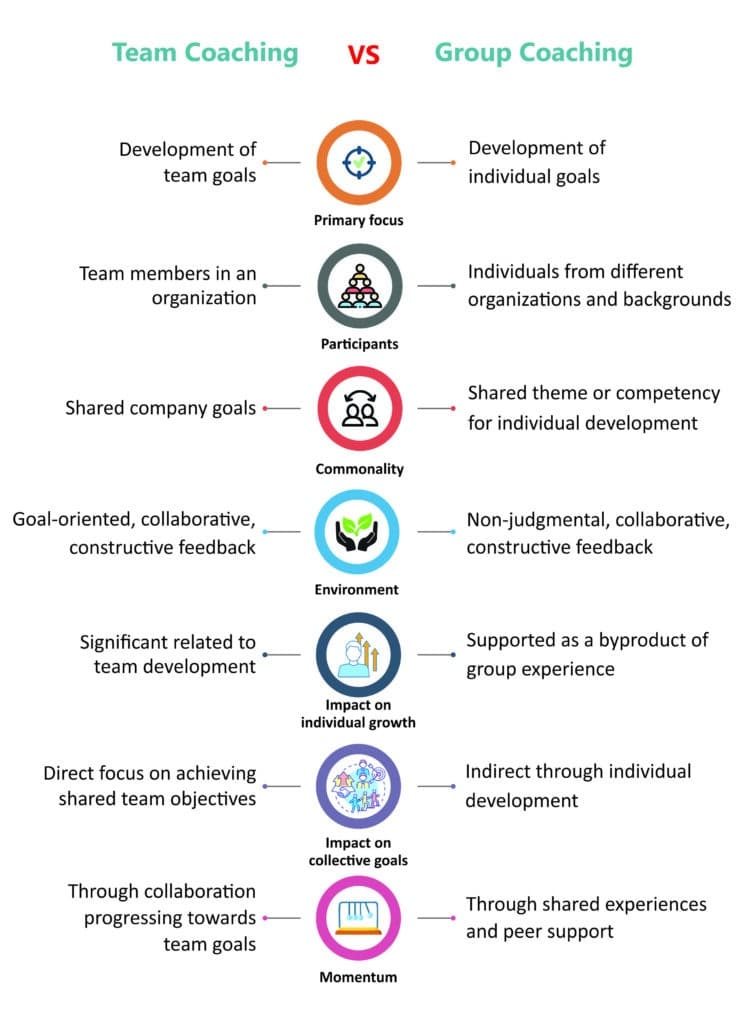In recent times, business coaching has emerged as a solution for transforming organizations, their teams, and leaders. Almost 80% of participants witness an increase in their confidence. Approximately 75% of organizations have seen an increase in their revenues after a successful intervention.
Business coaching may either be group or team programs. While these cater to multiple participants, there are some differences that may not be instantly visible. This blog explores the differences and similarities between the two and how these can impact organizational growth.
Team Coaching
Team coaching programs include people working together to improve their performance. Collaboration between team members increases participants’ motivation to work towards organizational goals and achieve the desired results.
Benefits of team coaching
Team coaching training has multiple benefits and goes a long way to increase collaboration (36%) while reducing employee turnover (32%) and improving bottom lines (18%). Some additional benefits include:
- Aligning decisions to meet overall organizational objectives
- Developing inspiring vision
- Taking responsibility for actions and results
- Working towards a common goal
- Building healthy teams with clearly defined objectives
What is group coaching?
Group coaching programs are collaborative and structured processes where the coach works with multiple participants to help them achieve their personal and professional goals. Multiple participants work together towards a common theme but may have different individual goals. Unlike team members, group coaching participants may not have a common objective.
Often, group interventions do not use standard models and theories but encourage effective thinking. Some strategies include structured questionnaires, plenary coaching, group activities, discussing critical cases, peer consultations, sharing experiences, and learning diaries.
Benefits of group coaching
Helps to solve problems collectively as it encourages participants to clarify challenges, identify potential solutions, and collectively define action steps. Participants from different backgrounds come together to share their knowledge and contribute unique perspectives.
Leadership group coaching training fosters an environment of accountability and support. This ensures every participant applies the strategies learnt during the coaching sessions and completes their assignments.
Group coaching encourages close engagement among the participants and a strong focus on helping each other to form a confidential and close bond. This encourages participants to rely on each other to achieve their individual and collective goals.
Participants in group training share their personal experiences and unique perspectives to offer open and honest feedback while sharing useful resources thereby creating an excellent opportunity to grow their networks.
Team coaching versus group coaching

Similarities between team and group coaching
- Focus on improving performance and skills
- Build momentum while collaborating with other participants
- Involves several participants often limited to under 10 individuals
- Supports individual growth while progressing towards collective goals and mission
- Creates a collaborative environment by providing constructive feedback and answering questions
Picking the right coaching intervention
Group and team coaching are used in diverse situations for different aims. Organizations must articulate the desired objectives from the coaching intervention, determine the corporate values, and establish a clear vision and strategy. Business owners must identify the gaps before choosing the coaching intervention to ensure productive results.
Group and team coaching aim to enhance group dynamics but each of these has its own methodologies and purpose. Nonetheless, there are certain similarities between the two and coaches may use different strategies to deliver breakthrough results and provide successful interventions for their clients.
Both these types of coaching programs are catalysts for individual and organizational growth in the right manner. These can be beneficial at different levels and companies must identify their requirements and plan to ensure the intervention offers maximum benefits.





